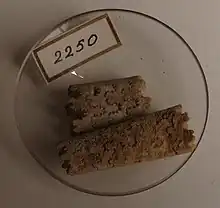Eubaculites
Eubaculites is an extinct genus of cephalopods in the family Baculitidae and each known species was initially placed within the related genus Baculites[1][2][3] until it was placed in a separate genus in 1926.[4]
| Eubaculites | |
|---|---|
 | |
| Eubaculites faujasi fossils in the Teylers Museum, The Netherlands | |
| Scientific classification | |
| Domain: | Eukaryota |
| Kingdom: | Animalia |
| Phylum: | Mollusca |
| Class: | Cephalopoda |
| Subclass: | †Ammonoidea |
| Order: | †Ammonitida |
| Suborder: | †Ancyloceratina |
| Family: | †Baculitidae |
| Genus: | †Eubaculites Spath, 1926 |
| Type species | |
| †Eubaculites ootacodensis (Stoliczka, 1866) | |
| Other species | |
Eubaculites existed from the Turonian until the Danian, and is one of the very last species of ammonites, going extinct roughly 64.5 million years ago, which was around 500,000 years after the start of the Cenozoic. Specimens found in the Maastricht Formation in The Netherlands suggest that at least one species (E. carinatus) survived the K-Pg mass extinction event, albeit being restricted to the Danian.[5][6][7][8][9]
References
- "Stoliczka, Ferdinand". doi:10.1553/0x00284f56.
{{cite journal}}: Cite journal requires|journal=(help) - P. D. Ward, W. J. Kennedy. (1993). Maastrichtian ammonites from the Biscay region (France, Spain). The Paleontological Society Memoir: 1--58.
- R. O. Brunnschweiler. (1966). Upper Cretaceous ammonites from the Carnarvon Basin of Western Australia I: the heteromorph Lytoceratina. Bureau of Mineral Resources, Geology and Geophysics Bulletin 58:1-58
- Spath, L. F. (1926). "On New Ammonites from the English Chalk". Geological Magazine. 63 (2): 77–83. doi:10.1017/s0016756800083710. ISSN 0016-7568. S2CID 128584535.
- Landman, Neil H.; Goolaerts, Stijn; Jagt, John W.M.; Jagt-Yazykova, Elena A.; Machalski, Marcin (2015), Klug, Christian; Korn, Dieter; De Baets, Kenneth; Kruta, Isabelle (eds.), "Ammonites on the Brink of Extinction: Diversity, Abundance, and Ecology of the Order Ammonoidea at the Cretaceous/Paleogene (K/Pg) Boundary", Ammonoid Paleobiology: From macroevolution to paleogeography, Topics in Geobiology, Dordrecht: Springer Netherlands, vol. 44, pp. 497–553, doi:10.1007/978-94-017-9633-0_19, ISBN 978-94-017-9632-3, retrieved 2021-10-26
- Machalski, Marcin; Heinberg, Claus (2005-12-01). "Evidence for ammonite survival into the Danian (Paleogene) from the Cerithium Limestone at Stevns Klint, Denmark". Bulletin of the Geological Society of Denmark. 52: 2005–12. doi:10.37570/bgsd-2005-52-08.
- Machalski, M.; Jagt, J. W. M.; Heinberg, C.; Landman, N. H.; Hakansson, E. (2009). "Dańskie amonity - obecny stan wiedzy i perspektywy badań". Przegląd Geologiczny (in Polish). 57 (6): 486–493. ISSN 0033-2151.
- W. M. Jagt, John (2012-01-01). "Ammonieten uit het Laat-Krijt en Vroeg-Paleogeen van Limburg". Grondboor & Hamer. 66 (1): 154–183.
- "Late Maastrichtian and earliest Danian scaphitid ammonites from central Europe: Taxonomy, evolution, and extinction - Acta Palaeontologica Polonica". www.app.pan.pl. Retrieved 2021-10-26.
This article is issued from Wikipedia. The text is licensed under Creative Commons - Attribution - Sharealike. Additional terms may apply for the media files.